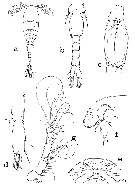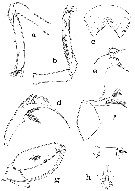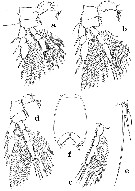|
|
 |
|
Cyclopoida ( Order ) |
|
|
|
Lubbockiidae ( Family ) |
|
|
|
Laitmatobius ( Genus ) |
|
|
| |
Laitmatobius crinitus Humes, 1987 (M) | |
| | | | | | | Ref.: | | | Humes, 1987 (p.663, figs.M ); Huys & Böttger-Schnack, 1996/97 (p.257); Boxshall & Halsey, 2004 (p.577, fig.M) |  Issued from : A.G. Humes in Bull. mar. Sc., 1987, 41 (3). [p.664, Fig.9]. Male (from 27°00'N, 111°30'W): a, habitus (dorsal); b, urosome (dorsal); c, segment bearing P5 and genital segment (lateral); d, caudal ramus (dorsal); e, rostrum (ventral view); f, same (lateral view); g, A1 (ventro-inner). Nota: Pedigerous somite of P1 longer than following pedigerous segments, distinctly separated from cephalosome. - Epimeral areas of metasomal segments not prominent. - Segments of P2-P4 dorsally with longitudinal and obique sclerotized bars. - Ratio of length to width of prosome 2.3 : 1. - Ratio of length of prosome to that of urosome 1.45 : 1. - Genital segment elongate. - Four postgenital segments. - Caudal ramus elongate; ratio 2.71 : 1. Outer lateral seta and smooth, outermost terminal seta smooth; dorsal seta, innermost terminal seta, and 2 median terminal setae, long, all curled and with delicate lateral hairs. - Body surface withe sensilla and refractile points (as fig.9a, b). - Rostrum shallowy rounded in ventral view butt forming blunt lobe in lateral view; surface with conspicuous refractile areas. - A1 5-segmented. 5th segment showing partial crease but still entire segment. Length of segments 26 (55µm along anterior margin), 62, 10, 78 and 86 µm respectively. Formula armature: 4, 13, 4, 4, 11 +1 aesthete, all setae smooth; segments 2, 4 and 5 with certain setae very long and curled
|
 Issued from : A.G. Humes in Bull. mar. Sc., 1987, 41 (3). [p.666, Fig.10]. Male: a, A2 (anterior); b, same (posterior; c, labrum (ventral); d, Md (posterior); e, Mx1 (anterior); f, Mx2 (postero-outer); g, Mxp (antero-inner); h, area between Mxp and P1 (ventral). Nota: A2 4-segmented with 4 small terminal claws. 1st segment unusually long and slender. Formula1, 1, 3, and 2 + IV. Seta on 1st segment very small. All setae naked. 3rd and 4th segments with spinules on posterior surface. - Labrum with 2 posteroventral lobes bluntly pointed, surface bearing refractile points. - Md elongate, basal portion bearing 2 spinulose outer spines and 1 inner seta plumose both laterally and superficially; distal portion forming long lash with its proximal outer area expanded and serrate. - Paragnath not seen. - Mx1 bilobed, smaller lobe bearing 3 nearly equal setae and row of minute spinules, larger lobe with 2 unequal setae. All setae minutely barbed. - Mx2 2-segmented. 1st segment expanded and unarmed; 2nd segment, small slender, bearing 1 naked subterminal seta and 2 terminal spines both with long spinules. - Mxp 4-segmented (assuming proximal part of claw to represent 4th segment). 1st segment short, broad with row of small spinules distally; 2nd segment elongate with 2 patches of spinules and 2 small unequal setae, 2 sensilla on postero-outer surface; 3rd segment small and unarmed, with sclerotization suggesting division of segment. Claw slender and long, with 1 small inner seta near base.
|
 Issued from : A.G. Humes in Bull. mar. Sc., 1987, 41 (3). [p.667, Fig.11]. Male: a, P1 and intercoxal plate (anteror); b, P2 (posterior); c, endopod of P3 (anterior); d, P4 (anterior); e, P5 (dorsal); f, genital segment with P6 (ventral). Nota: P5 with small unornamented free segment 21 x 8 mm. Two unequal terminal setae 57 µm (outer) and smooth, and 1212 µm (inner) with few delicate hairs. Adjacent dorsal seta 42 µm.
|
 Issued from : A.G. Humes inBull. mar. Sc., 1987, 41 (3). [p.665]. Male: Setal formula of swimming legs P1 to P4.
|
 Issued from : G.A. Boxshall & S.H. Halsey in The Ray Soc., 2004, No 166, Part II. [p.576, Fig.186, E]. Male: E, A2. :Generic and species diagnosis: 1 - P1 and P2 with outer spines on 3rd exopodal segment. 2 - Antennary endopod 3-segmented. (coxa and basis forming unarmed coxobasis, 1st endopodal segment with 1 seta; 2nd and 3rd segments free)
| | | | | NZ: | 1 | | |
|
Distribution map of Laitmatobius crinitus by geographical zones
|
| | | | Loc: | | | G. of California (Guaymas Basin)
Type locality: 27°00' N, 111°30' W. | | | | N: | 1 | | | | Lg.: | | | (935) M: 1,29-1,38; {M: 1,29-1,38} | | | | Rem.: | Deep-sea vents (2000 m). After Humes (1987, p.668) the lack of females makes assignment to family difficult.
The affinities of Laitmobius are clearly with the poecilostomatoid family Oncaeidae Giesbrecht, 1892, and particularly with species of Lubbockia Claus, 1862 (Boxshall, pers. comm.). Several features of the appendages suggest this relationship: 1- the segmentation of the male A1; 2- the armature of Md; 3- the form of Mx1; 4- the structure of Mx2; 5- the formula for the armature of P1-P4; 6- the nature of P5. | | | Last update : 12/10/2015 | |
|
|
 Any use of this site for a publication will be mentioned with the following reference : Any use of this site for a publication will be mentioned with the following reference :
Razouls C., Desreumaux N., Kouwenberg J. and de Bovée F., 2005-2025. - Biodiversity of Marine Planktonic Copepods (morphology, geographical distribution and biological data). Sorbonne University, CNRS. Available at http://copepodes.obs-banyuls.fr/en [Accessed November 30, 2025] © copyright 2005-2025 Sorbonne University, CNRS
|
|
 |
 |







